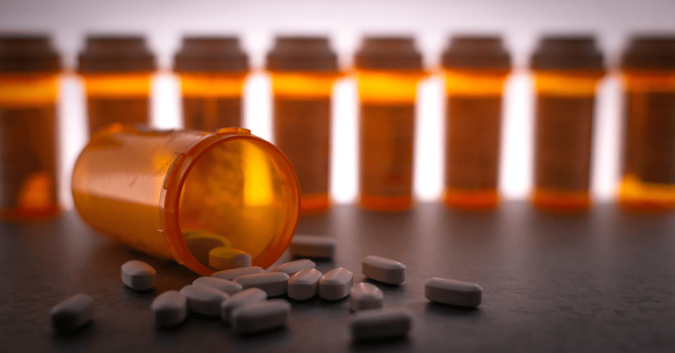In a first for the United States, a court has ruled that a drug manufacturer is responsible for fueling and escalating the opioid epidemic that's killed thousands of people. On Monday, a judge in Oklahoma ordered Johnson & Johnson to pay the state $572 Million, claiming the pharmaceutical giant and its subsidiary Janssen Pharmaceuticals, Inc. used deceptive marketing tactics to mislead patients and doctors over the dangers of its painkilling drugs.
In his ruling, District Judge Thad Balkman said the company "caused an opioid crisis that’s evidenced by increased rates of addiction, overdose deaths, and neonatal abstinence syndrome."
It marks the first time a company has been held responsible by a court for inflaming the opioid crisis in America.
Prosecutors argued that, beginning in the 1990s, Johnson & Johnson aggressively marketed its addictive painkillers to doctors while repeatedly downplaying the risks. One especially harmful practice was reported in the New York Times: J&J marketers worked to persuade doctors that if patients were asking a doctor for larger doses of an opioid, it was not because the patients were addicted — it was just because they needed more of a drug to treat their pain.
On Wall St, Investors… Celebrate?
While Monday's ruling marks a legal loss for the makers and sellers of highly addictive drugs, many on Wall St. considered it a victory for the industry. The $572 Million fine imposed by Judge Balkman is considerably less than the $17.5 Billion that the state of Oklahoma had asked for.
It's also a tiny sum next to the $81.6 Billion in sales Johnson & Johnson earned last year. In response to Monday's ruling, the company's stock rose by more than 2%. Competing drug makers Mallinckrodt, Teva Pharmaceutical, and Endo International also saw their shares increase. In a statement, Johnson & Johnson also said it plans to appeal the ruling.
Even if Johnson & Johnson loses the appeal, the fine is certain to have almost no impact on the company's bottom line. But others say it's not about the number. Legal experts say the court ruling could provide a roadmap for plaintiffs in other cases. Some point to the possibility of a global settlement covering all pending litigation against opioid drug makers.
Since the ruling, a number of powerful defendants in other cases have shown signs they are willing to cut a deal. NBC News reported on Tuesday that Purdue Pharma, the makers of OxyContin, is offering to settle more than 2,000 pending lawsuits against the company for anywhere between $10 Billion and $12 Billion.
Similar to the Johnson & Johnson case, those against Purdue have been brought by states, cities, and counties that say the company and its owners, the Sackler family, used deceptive marketing practices that fueled the opioid crisis across the country.
“The Sackler family built a multibillion-dollar drug empire based on addiction,” said New Jersey state attorney general Gurbir Gerwal when his state announced a lawsuit in May.
But, also like Johnson & Johnson, Purdue remains steadfast in denying responsibility for sustaining the crisis. The company had originally been a defendant in the same case brought by the state of Oklahoma but opted in March to settle rather than go to trial.
A Roadmap for Future Litigation
This week's Johnson & Johnson ruling could provide guidance for prosecutors in future opioid-related cases. At the heart of the trial was the question of whether or not the company's practices could be considered a "public nuisance." Prosecutors were charged with proving that the drug company's actions had "compromised the health and safety of thousands of Oklahomans."
In his ruling Monday, Judge Balkman said, “The state met its burden that the defendants Janssen and Johnson & Johnson’s misleading marketing and promotion of opioids created a nuisance."
In a press conference, Oklahoma Attorney General Mike Hunter laid out the strategy of his legal team:
"We showed how the company repeatedly ignored warnings by the federal governments and its own scientific advisers about the dangers of its drugs and the risks of marketing its products the way it did."
"We can never bring back those who have lost their lives," Hunter continued, as quoted by CBS News, "because Johnson & Johnson executives made the calculated and cold-blooded decision that they were going to produce a mutant strain of poppy, corner the market, and supply massive amounts of the active ingredients for other companies to manufacture opioids around the nation and in Oklahoma."
But the legal disputes over who is responsible for the opioid crisis are far from over. Johnson & Johnson is still facing a number of other lawsuits in other states, including a fresh case filed in West Virginia just last week.
Meanwhile, the Centers for Disease Control and Prevention (CDC) estimate some 130 Americans are killed each day as a result of overdosing on an opioid drug.
Between 1999 and 2017, more than 400,000 people died from opioid overdoses, with the number of overdoses deaths being six times higher in 2017 than it was in 1999.
